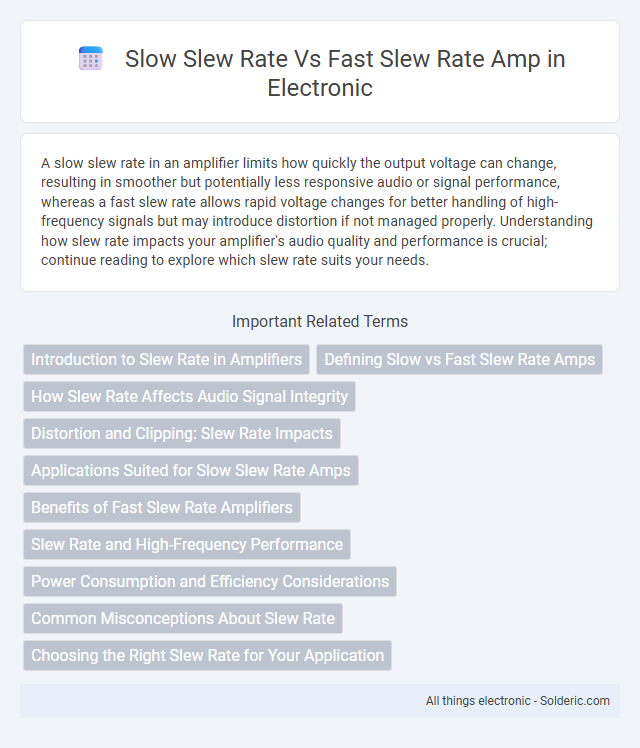A slow slew rate in an amplifier limits how quickly the output voltage can change, resulting in smoother but potentially less responsive audio or signal performance, whereas a fast slew rate allows rapid voltage changes for better handling of high-frequency signals but may introduce distortion if not managed properly. Understanding how slew rate impacts your amplifier's audio quality and performance is crucial; continue reading to explore which slew rate suits your needs.
Comparison Table
| Feature | Slow Slew Rate Amplifier | Fast Slew Rate Amplifier |
|---|---|---|
| Slew Rate | Low (e.g., <1 V/us) | High (e.g., >10 V/us) |
| Bandwidth | Limited | Wide |
| Signal Distortion | Higher at high frequencies | Minimal |
| Transient Response | Slow, potential overshoot | Fast, precise |
| Applications | Low-frequency audio, instrumentation | High-speed data, RF, video amplifiers |
| Power Consumption | Lower | Higher |
| Cost | Lower | Higher |
Introduction to Slew Rate in Amplifiers
Slew rate in amplifiers measures how quickly the output voltage can change in response to a rapid input signal, expressed in volts per microsecond (V/us). A slow slew rate limits the amplifier's ability to accurately reproduce high-frequency signals, resulting in distortion or signal lag, especially in audio and high-speed applications. Fast slew rate amplifiers handle rapid transient signals more efficiently, preserving signal integrity and reducing distortion in dynamic or high-bandwidth scenarios.
Defining Slow vs Fast Slew Rate Amps
A slow slew rate amplifier limits the speed at which its output voltage changes, typically measured in volts per microsecond (V/us), resulting in better stability and reduced high-frequency noise but potential distortion in fast signal transitions. Conversely, a fast slew rate amplifier can rapidly adjust its output voltage, enabling accurate reproduction of high-frequency signals and sharp waveform edges, ideal for high-speed applications. Your choice between slow and fast slew rate amps depends on trade-offs between signal fidelity, bandwidth requirements, and noise performance.
How Slew Rate Affects Audio Signal Integrity
A slow slew rate in an amplifier limits the maximum rate at which the output voltage can change, causing distortion and loss of high-frequency detail in audio signals, particularly during rapid transients. A fast slew rate preserves the integrity of sharp signal edges and transient responses, essential for accurate reproduction of high-fidelity audio and minimizing crossover distortion. Slew rate directly impacts signal fidelity, linearity, and audio clarity, with higher slew rates enabling better handling of complex, dynamic audio waveforms.
Distortion and Clipping: Slew Rate Impacts
Slow slew rate amplifiers often cause increased distortion and early clipping, especially in high-frequency or rapidly changing signals, due to their inability to accurately track swift voltage changes. Fast slew rate amplifiers minimize distortion and prevent clipping by responding promptly to rapid input variations, preserving signal integrity and clarity. Understanding your application's frequency demands ensures you select an amplifier with an optimal slew rate to reduce waveform distortion.
Applications Suited for Slow Slew Rate Amps
Slow slew rate amplifiers excel in applications requiring high precision and low distortion, such as audio signal processing, instrumentation, and sensor interfacing. They minimize overshoot and ringing in low-frequency and DC signals, making them ideal for measurement equipment and analog filters. These amps are preferred when stability and accuracy outweigh the need for rapid response times.
Benefits of Fast Slew Rate Amplifiers
Fast slew rate amplifiers provide rapid response to rapid input signal changes, minimizing distortion and signal delay in high-frequency applications. They enhance the accuracy of transient signal reproduction, crucial in precision instrumentation, RF communication, and high-speed data acquisition systems. The improved slew rate ensures better overall bandwidth performance, supporting faster signal processing and higher fidelity output.
Slew Rate and High-Frequency Performance
A slow slew rate in an amplifier limits its ability to accurately reproduce rapid voltage changes, resulting in distortion at high frequencies and poor overall signal fidelity. Fast slew rate amplifiers handle high-frequency signals more effectively, ensuring cleaner transitions and better performance in applications such as audio and RF circuits. Your choice of amplifier depends on the required bandwidth and the nature of the signals being amplified to avoid slew-induced distortion.
Power Consumption and Efficiency Considerations
Slow slew rate amplifiers consume less power due to their reduced switching activity, making them ideal for battery-operated or energy-sensitive applications. Fast slew rate amplifiers, while providing superior signal fidelity and faster response times, generally draw more current and may compromise overall efficiency in low-power designs. Your choice should balance the need for speed and accuracy with power consumption constraints to optimize system performance.
Common Misconceptions About Slew Rate
Many engineers mistakenly believe a faster slew rate always means better amplifier performance, but this overlooks distortion factors such as harmonic and intermodulation distortion. A slow slew rate can cause slew-induced distortion when the amplifier cannot keep up with rapid input signal changes, leading to signal degradation especially in high-frequency applications. Properly matching slew rate to the intended signal bandwidth and linearity requirements is crucial to avoid inefficiencies and ensure optimal audio or analog signal fidelity.
Choosing the Right Slew Rate for Your Application
Choosing the right slew rate for your application depends on the signal frequency and amplitude to ensure accurate waveform reproduction without distortion. A slow slew rate amplifier provides cleaner signals with lower noise for audio and low-frequency applications, while a fast slew rate amp is essential for high-speed circuits and fast transient responses. Understanding your circuit's speed requirements helps optimize performance and avoid signal degradation caused by slew rate limitations.
slow slew rate vs fast slew rate amp Infographic

 solderic.com
solderic.com